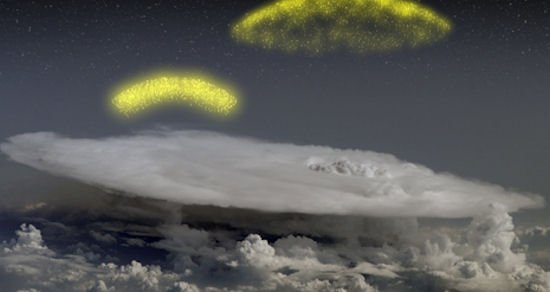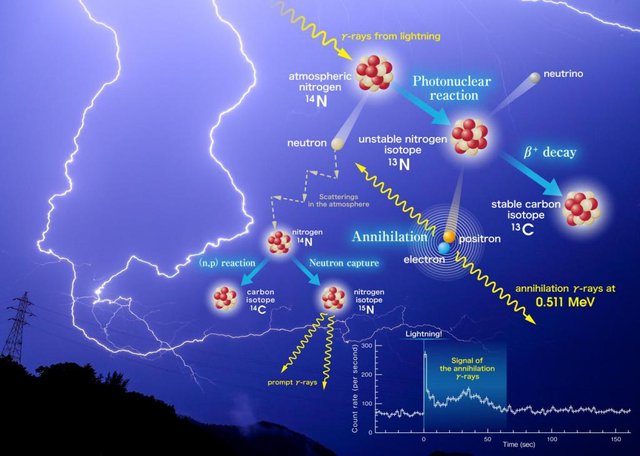Discovery! Incredible things happen in thunderstorms: huge explosions, X-rays, radiation like those of the H bomb. And there's even antimatter, a substance that is the same and opposite to …
Imagine a planet on which the storms produce beams of antimatter, the specular substance, with opposite charges, of matter. Antimatter is an extraordinary substance, capable of turning 100% into energy and propelling the spaceships of the future, as already imagined in the TV series Star Trek.
If astronomers found such a planet, it would already be an extraordinary discovery. But if it turns out that this planet is the Earth ... we would not believe it! Yet it is so. This was demonstrated by an artificial satellite, which on December 14, 2009 was hit by a beam of antimatter generated by a storm at 5,000 km away. How was it possible? To understand it well, a long introduction is required.
LIKE A BLACK HOLE
Scientists have known for several years that some storms, especially in tropical regions, can produce flashes of energy radiation such as those generated by atomic bombs: gamma rays. These radiations are the most penetrating ever, far more than the X-rays used for radiographs. And they are emitted from the most extreme celestial bodies, like black holes.
In fact, the terrestrial gamma-ray bursts generated by thunderstorms were discovered by chance, in the 90s, by the artificial satellites that searched the celestial sky in search of black holes devouring matter and other equally violent cosmic phenomena.
At the beginning nobody expected that such extreme phenomena would occur in our atmosphere, and since then many scientists and various satellites.
SOME YES, OTHERS DO NOT
It seems that this fascinating physical phenomenon, which in many ways still remains mysterious, begins with a flow of electrons accelerated upwards from the electric fields of the storm, until reaching speeds close to that of light in the void. These hypervelic electrons, colliding with atoms in the atmosphere, release energy and produce gamma rays.
However, many aspects remain to be clarified:
"Terrestrial gamma-ray bursts are produced by storms of all shapes and sizes," explains Joseph Dwyer, professor of physics in the US "but we still do not know why some thunderstorms produce gamma-ray bursts and others do not."
EQUAL AND OPPOSITE
Whatever their origin, it seems that all the terrestrial gamma-ray bursts produce antimatter. In fact, gamma rays are very concentrated packets of energy. And, when they hit an atom, they can materialize into two equal and opposite particles: an electron and a positron (or antielectron). A positron is like an electron in the mirror: same mass and electric charge of opposite sign (the electron has a negative charge, the positron positive). Electrons and positrons, if they were always separated, would live each of their own life, forever ... but, if they meet, they disintegrate instantly, releasing energy: in practice, they vanish and in their place the gamma rays remain. A "miracle" made possible by the famous Einstein formula E = mc 2 , according to which the energy (gamma rays) can be transformed into matter (particles and antiparticles) and vice versa.
PARTICLES WITH COMPASS
Even gamma rays that are formed during storms, colliding with atoms in the atmosphere, produce electron and anti-electron pairs. So they create a cloud of matter, and an equal and opposite antimatter. These particles and antiparticles, however, do not stand where they are, but - as if they were to follow a compass - are directed from the Earth's magnetic field to the South Pole or the North Pole, depending on their electrical charge and their speed.
With these premises in mind, we can finally reconstruct, step by step, what happened on December 14, 2009, when the first antimatter flow generated by a thunderstorm was recorded.

Credits
It all started in Zambia, where a storm was raging. While the lightning strikes on the ground, a flash of gamma rays was released at high altitudes, which in turn generated a cloud of matter (electrons) and one of antimatter (positrons).
The antimatter, at least in part, was channeled along the Earth's magnetic field, heading north. And when it passed over Egypt, it hit the Fermi satellite of NASA and was registered by its instruments. In practice, the antimatter of the speech bubble and the matter of the satellite collided and annihilated, generating energy and activating the measuring instruments. If the quantities of matter and antimatter had been the same, the satellite would have completely disintegrated. But the antimatter produced by a thunderstorm is very little: "Just a nanogram (that is, a thousandth of a millionth of a gram)," estimates Michael Briggs . That is, less than a grain of dust: enough to free 360 thousand Joules, that is to make a 100 W lamp shine for half an hour. In the collision, therefore, only a very small part of the satellite has disintegrated.
LIKE A SPRING
The story doesn't end here. Because the antimatter cloud, even after colliding (and partially annihilated) a first time with the satellite, has continued its path along the Earth's magnetic field. Until you reach a point in the atmosphere "mirror" to that in which the storm happened and bounce back. The Fermi satellite, in fact, recorded a second wave of antimatter 23 thousandths of a second later: a sort of echo of the main signal.
How did this reflection happen?
Joseph Dwyer answers: "The charged particles (electrons and positrons) move along the lines of the Earth's magnetic field following a spiral trajectory. As the particles approach the Earth, the magnetic field intensifies, with the result that the particles spiral faster but advance more slowly. Until you go back ".
In practice, Briggs explains, the spiral trajectory of the particles resembles a spring, which at first lengthens (when the antimatter moves away from the original storm) and then collapses (when, after passing the equator, it gets closer to the Earth) ... to the point where the "spring bounces", and the particles are reflected back.
IS THERE A DANGER FOR US?
There remains a doubt: when there is a storm, in addition to lightning, do we have to worry about being surrounded by penetrating radiation and even antimatter? For those on the Earth's surface, the answer is certainly no, there is no fear, because all these phenomena occur at altitude ... And for airplanes and artificial satellites?
The antimatter generated by storms is so small and diluted that it should not damage satellites," explains Briggs. "According to some calculations, however, if an airplane passes near a gamma-ray flash, passengers could receive a significant amount of radiation. This, however, is a statistically very remote event.
On the other hand, research has just begun.
"In addition to scientific interest," concludes Dwyer, "these studies are important for determining the type and amount of radiation present in thunderstorms at altitudes where airplanes fly."
And to reiterate, however, that, in doubt, from a strong storm it is always better to stay away.



Downvoting a post can decrease pending rewards and make it less visible. Common reasons:
Submit